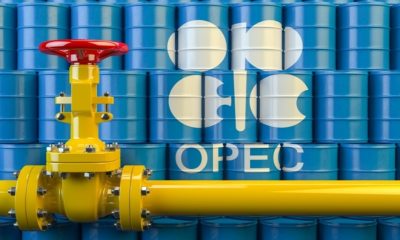The Organisation of Petroleum Exporting Countries (OPEC) yesterday lifted its forecast on its members’ crude this year by over 200,000 bpd and now expects demand for its own crude to average 27.65mn bpd in 2021.
This is almost 5.2mn bpd higher than last year and around 2.7mn b/d higher than an earlier estimate of the group’s April production.
According to the highlights of the organisation’s latest Monthly Oil Market Report (MOMR), OPEC crude is projected to rise from 26.48 million bpd in the second quarter to 28.7 million bpd in the third and 29.54 million bpd in the fourth quarter of the year.
The report also indicated a fall in Nigeria’s crude production from 1.477 bpd in February to 1.473, a difference of just about 4,000 bpd before rising again in April to 1.548 million bpd, to add 75,000 bpd last month.
OPEC stated that its upward revision of members’ crude was underpinned by a downgrade in the group’s forecast for non-OPEC supply, which it now expects to grow by 700,000 bpd to 63.6mn b/d against last month’s report’s projection of a 930,000 bpd rise to 63.83mn bpd.
The oil cartel projected that US crude output would drop by 280,000 bpd this year, compared with its previous forecast for a 70,000 bpd decline.
On the demand side, OPEC kept its overall forecast unchanged from last month’s MOMR, stressing that it expects global oil demand to grow by 5.95 million bpd to 96.46 million bpd this year, partly reversing last year’s 9.48mn bpd drop.
Spot crude prices fell in April for the first time in six months, with North Sea Dated and WTI easing month-on-month by 1.7 percent and 1 percent, respectively.
On the global economic projections, the cartel said stimulus measures in the US and accelerating recovery in Asian economies might continue supporting the global economic growth forecast for 2021, now revised up by 0.1 percent to reach 5.5 percent year-on-year.
This comes after a 3.5 percent year-on-year contraction estimated for the global economy in 2020.
However, global economic growth for 2021 remains clouded by uncertainties including, but not limited to the spread of COVID-19 variants and the speed of the global vaccine rollout, OPEC stated.
“World oil demand is assumed to have dropped by 9.5 mb/d in 2020, unchanged from last month’s assessment, now estimated to have reached 90.5 mb/d for the year. For 2021, world oil demand is expected to increase by 6.0 mb/d, unchanged from last month’s estimate, to average 96.5 mb/d,” it said.
The report listed the main drivers for supply growth in 2021 to be Canada, Brazil, China, and Norway, while US liquid supply is expected to decline by 0.1 mb/d year-on-year.

 Naira4 weeks ago
Naira4 weeks ago
 News4 weeks ago
News4 weeks ago
 Naira4 weeks ago
Naira4 weeks ago
 Travel3 weeks ago
Travel3 weeks ago
 Jobs4 weeks ago
Jobs4 weeks ago
 Naira3 weeks ago
Naira3 weeks ago
 Naira3 weeks ago
Naira3 weeks ago
 Investment4 weeks ago
Investment4 weeks ago


























